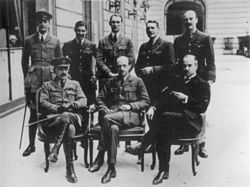Paris Peace Conference (1919–1920)
The Paris Peace Conference was the formal meeting in 1919 and 1920 of the victorious Allies after the end of World War I to set the peace terms for the defeated Central Powers.
Paris Peace Conference (1919–1920) Media
Johannes Bell of Germany is portrayed as signing the peace treaties on 28 June 1919 in The Signing of Peace in the Hall of Mirrors, by Sir William Orpen.
Mandates of the League of Nations
The Australian delegation, with Australian Prime Minister Billy Hughes in the center
Woodrow Wilson, Georges Clemenceau, and David Lloyd George confer at the Paris Peace Conference (Noël Dorville, 1919)
From left to right: Marshal Ferdinand Foch, Clemenceau, Lloyd George and the Italians Vittorio Emanuele Orlando and Sidney Sonnino
The Japanese delegation at the Conference, with (seated left to right) former Foreign Minister Baron Makino Nobuaki, former Prime Minister Marquis Saionji Kinmochi, and Japanese Ambassador to Great Britain Viscount Chinda Sutemi
"The Big Four" made all the major decisions at the Paris Peace Conference (from left to right, David Lloyd George of Britain, Vittorio Emanuele Orlando of Italy, Georges Clemenceau of France, and Woodrow Wilson of the United States).
Ukraine map presented by the Ukrainian delegation at the Paris Peace Conference in a bid that was ultimately rejected, which led to the incorporation of Ukraine into the Soviet Union. The Kuban was then mostly Ukrainian.









